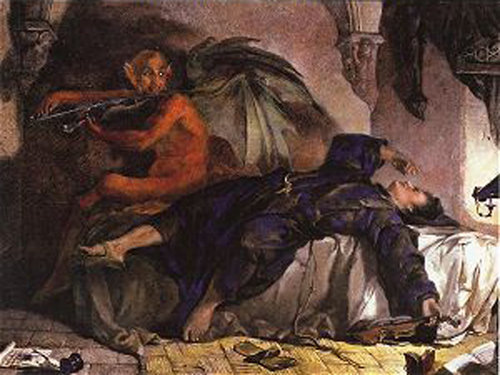"One night, in the year 1713 I dreamed I had made a pact with the devil for my soul. Everything went as I wished: my new servant anticipated my every desire. Among other things, I gave him my violin to see if he could play. How great was my astonishment on hearing a sonata so wonderful and so beautiful, played with such great art and intelligence, as I had never even conceived in my boldest flights of fantasy. I felt enraptured, transported, enchanted: my breath failed me, and - I awoke. I immediately grasped my violin in order to retain, in part at least, the impression of my dream. In vain! The music which I at this time composed is indeed the best that I ever wrote, and I still call it the ‘Devil's Trill,’ but the difference between it and that which so moved me is so great that I would have destroyed my instrument and have said farewell to music forever if it had been possible for me to live without the enjoyment it affords me."
So he didn’t quite capture the tune he heard in his dream, but Tartini shouldn’t have been so hard on himself. What he did manage to produce is still a gripping piece of music. The opening notes set the scene; the composer is consumed with longing and perhaps a dash of melancholy. The mood brightens briefly, suggesting the beauty that Tartini may have experienced in his dream. But just when you think things are looking up for our musical narrator, Skreeeeeeeeeeeee! That’s right; this work is a skreeeeeeee-for-all in its early stages.
But the twists and turns don’t end there. The battle between wistfulness and optimistic beauty – as suggested by frequent shifts in tempo and major/minor notes – rages on with no clear winner. In the second movement, we’re treated to a jumpy little theme as the notes pile up, producing a textured sound that keeps getting bigger and bigger. Before long, we find ourselves running at break-neck speed along a rocky path with an every-shifting terrain beneath our feet. Where are we? Is this…? Could it be…? Are we in H-E-double hockey sticks? Yes we are. It may have a bad reputation, but from a sonic standpoint, it’s not so bad here.
Eventually, we find ourselves back on more solid ground. The mood once again turns melancholy, then snarky, then melancholy, snarky, etc. Finally, the trilling (this piece is called the Devil’s Trill, remember?) becomes too fast, too furious and too spooky. It all breaks down in the end and we’re left with echoes of the themes from earlier in the piece. Thank you for the strange trip, Tartini. It was fascinating. But next time, you may want to pop a No-Doz when you feel the urge to sleep. I’m not sure I can handle many more musical side effects of satanic visitations.
There are plenty of performances of this piece on YouTube, but the one I’ve been listening to is from here. To my untrained ear, it is technically flawless and emotionally charged – necessary skills for such a demanding and personal piece. This site is great, by the way. Old classical musical performances that are too old to be copyrighted. Check it out.
Recording notes:
Composer: Giuseppe Tartini
Works: Devil's Trill Sonata
Performer: Gerhard Taschner (violin), Unknown (piano)
Year: 1949



No comments:
Post a Comment